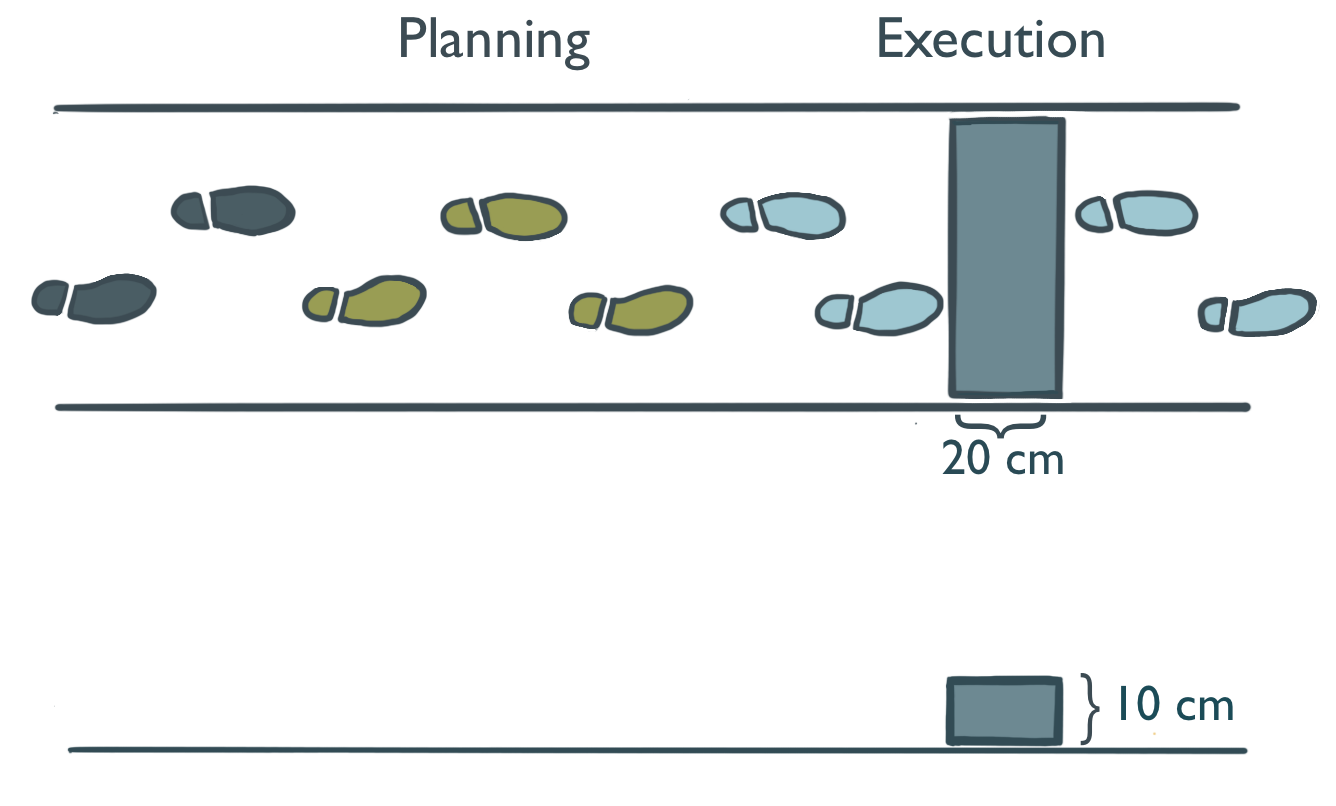Objective: To evaluate the effect of a TT and TT+VR[1] on obstacle crossing performance in PD subjects with an history of falls.
Background: It is well established that Dual Task (DT) gait ability is compromised in PD[2]. Indeed, DT gait interference becomes more apparent when attentional control cannot fully compensate for motor impairment due to basal ganglia pathology[2]. It has also been shown that DT impairments correlate with increased risk of falls[3], freezing of gait[4] and cognitive status[5]. In the VTIME study we already demonstrated that TT+VR was effective in reducing falls and improving gait under single and DT conditions in PD population[1]. However, we didn’t explore training effect on the planning and execution phases during complex gait task.
Method: We present a secondary analysis on obstacle negotiation task in a cohort of 141 PD subjects randomly assigned into two groups: TT and TT+VR. Training and data acquisition[7] are presented in previous works of VTIME consortium [1]. Participants performance was evaluated four times pre, post intervention, 1 and 6-month FU. We analyzed obstacle crossing considering two phases[8] [Figure1]: planning and execution. A selection of gait parameters[9] were estimated[7] and examined. To detect the effect of training over time we used a repeated‐measure (RM) ANOVA with TIME (PRE-POST-FU1M-FU6M) as within subject factors and TREATMENT (TT, TT+VR) as between subjects’ factors. (All data were acquired with VTIME consortium).
Results: Statistical analysis of planning phase showed significant TIME×TREATMENT interactions for: stride time (P=10-3) and stance time (P=3.5×10-6). While execution phase results exhibit statistical interactions for foot vertical displacement (P= 6×10-6). Post-hoc analyses revealed that stride time and stance time during planning were improved after TT treatment (respectively with P=1.3×10-6, P=5.4×10-7) whereas foot vertical displacement that showed positive change after TT+VR training (P=1.9×10-3).
Conclusion: Our results suggest that TT and TT+VR act on DT performances differently. While TT has more benefit on some spatiotemporal parameters of gait in the planning phase, TT+VR improved significantly obstacle crossing phase, increasing foot vertical displacement. Improving the crossing phase could contribute to a safe gate under complex walking conditions.
(All data were acquired with Vtime consortium)
References: [1] A. Mirelman et al., “V-TIME: a treadmill training program augmented by virtual reality to decrease fall risk in older adults: study design of a randomized controlled trial.,” BMC Neurol., vol. 13, p. 15, Feb. 2013, doi: 10.1186/1471-2377-13-15. [2] L. Rochester, B. Galna, S. Lord, and D. Burn, “The nature of dual-task interference during gait in incident Parkinson’s disease.,” Neuroscience, vol. 265, pp. 83–94, Apr. 2014, doi: 10.1016/j.neuroscience.2014.01.041. [3] S. Heinzel et al., “Motor dual-tasking deficits predict falls in Parkinson’s disease: A prospective study.,” Parkinsonism Relat. Disord., vol. 26, pp. 73–77, May 2016, doi: 10.1016/j.parkreldis.2016.03.007. [4] J. Spildooren, S. Vercruysse, K. Desloovere, W. Vandenberghe, E. Kerckhofs, and A. Nieuwboer, “Freezing of gait in Parkinson’s disease: the impact of dual-tasking and turning.,” Mov. Disord., vol. 25, no. 15, pp. 2563–2570, Nov. 2010, doi: 10.1002/mds.23327. [5] M. Ranchet et al., “Changes in Prefrontal Cortical Activity During Walking and Cognitive Functions Among Patients With Parkinson’s Disease.,” Front. Neurol., vol. 11, p. 601686, 2020, doi: 10.3389/fneur.2020.601686. [6] A. Mirelman et al., “Addition of a non-immersive virtual reality component to treadmill training to reduce fall risk in older adults (V-TIME): a randomised controlled trial.,” Lancet (London, England), vol. 388, no. 10050, pp. 1170–1182, Sep. 2016, doi: 10.1016/S0140-6736(16)31325-3. [7] M. Bertoli et al., “Estimation of spatio-temporal parameters of gait from magneto-inertial measurement units: multicenter validation among Parkinson, mildly cognitively impaired and healthy older adults.,” Biomed. Eng. Online, vol. 17, no. 1, p. 58, May 2018, doi: 10.1186/s12938-018-0488-2. [8] F. Pieruccini-Faria, J. A. Jones, and Q. J. Almeida, “Motor planning in Parkinson’s disease patients experiencing freezing of gait: the influence of cognitive load when approaching obstacles.,” Brain Cogn., vol. 87, pp. 76–85, Jun. 2014, doi: 10.1016/j.bandc.2014.03.005. [9] A. Mirelman et al., “Gait impairments in Parkinson’s disease.,” Lancet. Neurol., vol. 18, no. 7, pp. 697–708, Jul. 2019, doi: 10.1016/S1474-4422(19)30044-4.
To cite this abstract in AMA style:
C. Ponte, M. Putzolu, A. Botta, C. Cosentino, A. Mirelman, JM. Hausdorff, L. Avanzino, E. Pelosin. Treadmill Training (TT) and TT plus virtual reality (TT+VR) act differently on obstacle crossing performance in subjects with PD [abstract]. Mov Disord. 2021; 36 (suppl 1). https://www.mdsabstracts.org/abstract/treadmill-training-tt-and-tt-plus-virtual-reality-ttvr-act-differently-on-obstacle-crossing-performance-in-subjects-with-pd/. Accessed December 26, 2025.« Back to MDS Virtual Congress 2021
MDS Abstracts - https://www.mdsabstracts.org/abstract/treadmill-training-tt-and-tt-plus-virtual-reality-ttvr-act-differently-on-obstacle-crossing-performance-in-subjects-with-pd/

